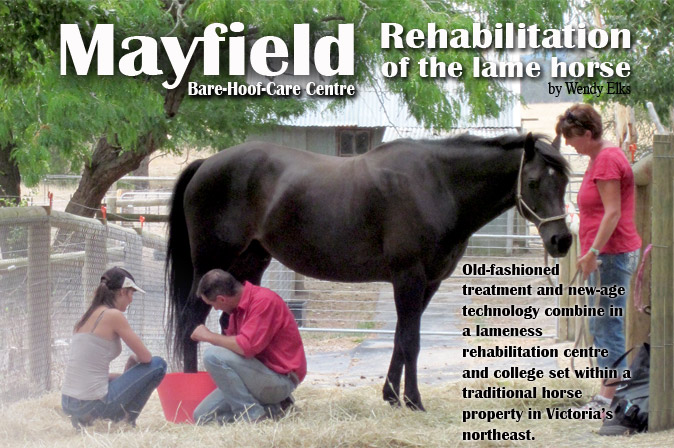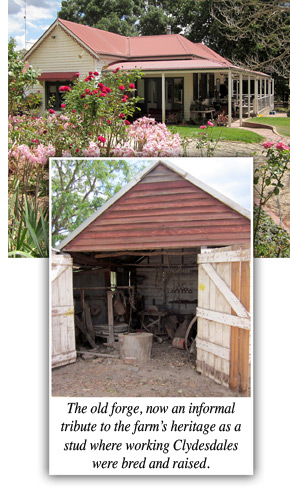Hoofbeats Article 

Mayfield - Rehabilitation of the lame horse
Bare Hoof Care Centre by Wendy Elks
 In stony, low-hilled ‘gold-mining’ country, not far from the tiny township of Yarck, in Central Victoria, lies Mayfield, a working farm with a long and proud equine tradition. First settled in the 1870s, the property was originally a Clydesdale stud that once ran a side business making the district’s dams and roads, using iron scoops harnessed to the stud’s powerful progeny. These days the strong equine tradition continues, but the work is done by humans in the aid of horses, rather than the other way round. In stony, low-hilled ‘gold-mining’ country, not far from the tiny township of Yarck, in Central Victoria, lies Mayfield, a working farm with a long and proud equine tradition. First settled in the 1870s, the property was originally a Clydesdale stud that once ran a side business making the district’s dams and roads, using iron scoops harnessed to the stud’s powerful progeny. These days the strong equine tradition continues, but the work is done by humans in the aid of horses, rather than the other way round.
Mayfield’s modern dual purposes, apart from raising feed and running cattle, combine 21st Century science and new-age holistic treatments with the time-honoured art of hoof trimming. In a somewhat ironic twist, the farm’s current part owner, master farrier Andrew Bowe, is the clinician for a barefoot rehabilitation centre for the chronically lame. Mayfield is also the campus of learning for a course in equine podiotherapy – a compound expression describing a hoof-trimming course based on scientific research, barefoot trimming and related subjects such as body work, biomechanics and nutrition.
The holistic nature of this course reflects the philosophy and principles of the treatment centre. Andrew Bowe and his wife Nicky, a former veterinary nurse for whom Mayfield is her childhood home, take in severely and chronically lame equine patients that traditional farriery haven’t been able to help. The old forge on the property is now a museum of sorts, and these days a horseshoe is rarely in sight, apart from Andrew’s compromise - the steel-sheet Laser Tip™
Hoof rehabilitation at Mayfield involves corrective trimming of a bare or shoeless foot, combined with living conditions designed to maximise healing, including movement, special ground surfaces, and diet. Hoof boots are often used on the horses to protect sore feet and encourage movement.
The Last Hope
Mayfield is often the last hope for severely compromised horses and ponies, delivered by owners who are desperate as their animals have been diagnosed with ‘untreatable’ navicular disease, laminitis, and poorly-formed hooves. Usually, their bodies are racked with postural issues, arising from unnatural stance through trying to alleviate sometimes agonising lameness. Often there is mild to severe rotation of the pedal bone, in some cases with the bone protruding through the sole.
Severe laminitis used to mean a death sentence, but serious cases that were once considered hopeless and euthanased without delay or question, are being routinely salvaged since the principles of barefoot rehabilitation were developed. “This rehabilitation is successful because it takes the pressure off the laminar attachment in both vertical ‘sinking’ and rotation, and allows healing to proceed,” Andrew Bowe says.
“Following veterinary diagnosis, barefoot rehab is a three-pronged process. The first aim is to identify and remove the cause (whether it is systemic, or in the feet). Comfort is provided with padded boots or rubber laneways, or even both, along with drugs (veterinary prescribed) and/or herbal support. Thirdly, we facilitate the growth of a new attachment by keeping all possible weight off the laminae, by removing any mechanical forces that perpetually tear compromised laminae apart.”

The purpose-built recovery/treatment area for acute lameness cases (above and right) is a covered arena-sized complex with brick
paving lined in the centre with rubber.
Restoring Function
The treatment regimen at Mayfield aims to restore horses back to useful soundness by returning correct form and function to deformed and dysfunctional feet. It is a grand aim, as navicular syndrome and laminitis are gravely serious conditions, about which there is still much to be learned. But with information amassing through modern research, building on revolutionary work done by early pioneers in this realm, the treatment of these diseases is being transformed.
Poor hoof form and dysfunction creates most lameness, and restoring these conditions can often correct the problem. Keeping the feet ‘bare’ facilitates the frequent (weekly) trimming necessary to correct horn growth, and also maximises blood circulation and hoof function – two essential elements in the development of true healing. Andrew Bowe’s belief in barefoot trimming defies the rich tradition of his chosen trade. “Years ago I started out looking for the ‘holy grail’ of the farrier – to solve navicular syndrome. The degenerative process is slow, and hoof problems are sub-clinical (not obvious) at first. Hoof deformity through incorrect trimming leads to loss of structure and integrity of the hoof capsule. Corrective trimming, I’ve found, is far more effective than corrective shoeing, which often just masks the underlying problem.”

Left: The stables are rarely used these days as movement is better for horses’ feet than standing around on bricks. Centre: Initially, horses are turned out onto long-yards laid with thick
rubber matting, allowing non-concussive comfort and therefore correct biomechanical movement. Right: The gravel long-yard, lined with pea gravel, which provides a comfortable and giving, yet slightly abrasive surface.
Treatment Process
Upon arrival, horses are trimmed and turned out onto long-yards laid with thick rubber matting, allowing comfortable and therefore correct biomechanical movement. The rubber sheeting on hard ground is non-concussive but firm enough to allow maximum hoof function on a properly trimmed bare hoof. It is also far cleaner for hooves with open sores.
The rubber yards lie just behind the century-old homestead’s rambling garden, a delightful a mix of formal grace, vegie patch, chook run, lawn and play areas for the Bowes’ two daughters. Plenty of large shade trees and an in-ground pool provide a comfortable lifestyle in the region’s warm and dry climate.
A brick path leads to the original stable complex, massive roundyard and connected yards and laneways, some of which are padded in rubber for sore horses. The home paddocks are now connected to long paddock/tracks for horses in recovery. A 500-metre track leads around paddocks below the house and a new 1500 metre track wraps around pasture to the northeast. Beyond the stables lies the purpose-built recovery/treatment area, a brick-paved and covered arena-sized complex. Acute lameness cases are housed here. The entire middle section of the area is lined with rubber, while the exposed brick on the outside edges forms an even, hard and easily cleaned surface for walking and trimming. Horses here are booted, sometimes on all four feet. Hay is provided ad-lib, and piled up for very sore horses to stand and lie down on. It is here where intensive care is given, and where podiotherapy students practice their skills, first on cadaver feet and then on the many horses living at Mayfield.
Horses progress from the rubber-matted consultation long-yard, to the intensive treatment area, then to a small paddock lined with pea gravel, which provides a comfortable and giving, yet slightly abrasive surface. Recovery is completed on the long runs out amongst pastures where there is nothing but space, sky and peace.
Depending on the type and severity of hoof distortion and lameness, the duration of a stay at Mayfield is from two to six months, in most cases. During this time patients’ diets are revisited, with particular attention to sugar content. “Diet can greatly affect hoof quality, and we lean towards using more natural feeds and feeding regimes,” Nicky Bowe says. Body issues are also addressed. “Many horses suffer tension and tightness from holding themselves in unnatural positions (sometimes for years) to try and avoid putting pressure on painful feet. We have a network of good body therapists whom we call on for help.”
Patients are well cared for by Nicky, who brings knowledgeable assistance and a lifetime of experience with horses to her role of nursing support. Coming back to where she grew up and first learned about riding and keeping horses adds another dimension to the rewards gained from turning around the lives of so many horses.
When horses go home, hopefully ready to resume a useful life, boots are recommended while the horse is being ridden, combined with a correct diet and physiologically correct ongoing hoofcare, so any future relapse should be prevented.

As hoof damage can be severe and prolonged, euthanasia remains an ever-present possibility in far-gone cases. Success is never guaranteed, but Andrew and Nicky claim that veterinary assisted diagnosis, physiologically correct trimming and correct living conditions give the best chance of resolving navicular syndrome, laminitis, and most chronic lameness issues.
Recovery at Mayfield is not prohibitively expensive in the later stages, when movement (preferably shared paddock agistment) and a natural diet are the most important elements along with regular trimming, which is a simple procedure when the correct path has been set. As the proprietors note, pain relief after the first trim can be almost instantaneous; thereafter, time and the right conditions are mostly what allow healing to occur.
Mayfield’s tradition of horsemanship and care has come full circle, from its days as a well-run working-horse farm to a modern-day clinic and vocational college, that strives to relieve horses’ suffering and discomfort.
Contact website: www.barehoofcare.com |